Author Archive
Skyline




Skyline, this company, is a low-budget breath of fresh air. In today’s Hollywood, where filmmakers routinely spend $100 million dollars only to make a really crappy movie, it’s good to know that for a tenth of that, they can make one just as bad.
Somewhere in Southern California, after a viewing of Cloverfield, I figure the two Strause brothers (aka, “The Brothers Strause”) turned to each other and said something like:
“Dude! Instead of music videos, we should make a Cloverfield movie–but about aliens!”
“Dude, you’re right! Kinda like Independence Day!”
“And The Matrix!”
“With stuff like from Aliens!”
“Dude!!”
Too bad it didn’t occur to them to use the good parts from those movies.
Plot Summary: Our heroic couple, Jarrod (Eric Balfour) and Elaine (Scottie Thompson) arrive in L.A. to visit their rich friend Terry (no relation to me), played by Scrubs alum Donald Faison. They all get eaten.
 The Story: Skyline has a terrific opening. Eschewing Hollywood’s trend of starting with a ton of backstory, it jumps right into action, suspense, and Scottie Thompson wandering around in her underwear. For about three minutes, that is. Then comes the “Fifteen hours earlier” flashback with a ton of backstory.
The Story: Skyline has a terrific opening. Eschewing Hollywood’s trend of starting with a ton of backstory, it jumps right into action, suspense, and Scottie Thompson wandering around in her underwear. For about three minutes, that is. Then comes the “Fifteen hours earlier” flashback with a ton of backstory.
The flashback begins with Jarrod and Elaine landing in L.A. to visit Jarrod’s old pal Terry. Elaine complains of being nauseated, probably because she just finished reading the script. They’re picked up by a limo and scooted away to a flat of luxury condos, where Terry lives in the penthouse with his bevy of babes and sycophants. Terry has made it big doing something with robots of some kind. Or maybe music. Or drugs. I’m not really sure, but the point is, he’s rich. He wants Jarrod to move out to L.A., but Jarrod isn’t so sure, especially after Elaine pulls that tired old, “Hey, I’m pregnant” gambit on him.

After a day of living the L.A. lifestyle of responsible drinking and low-key partying, the friends and sycophants pass out in Terry’s apartment. At 4:27 a.m., mysterious lights appear through the blinds. Ray, aka Sycophant #1, gazes at the lights and a special effect from the X-files suddenly crawls over his face. He opens the door to the balcony and disappears, to the horror of Sycophant #2 (Denise) to whom he must have owed money or something, because otherwise, I didn’t see a problem.
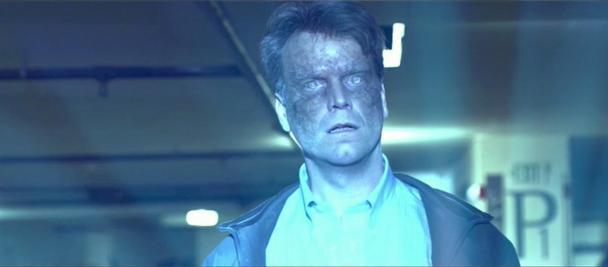
Denise’s screaming causes Jarrod and Elaine to meander into the mis-named “living room” to see what’s up. Jarrod nearly succumbs to the same special effect as Ray, but is pulled away from the light just in time. Clearly, however, he is infected, which would have foreshadowed something of great plot significance if either of the Brothers Strause had attended film school.
The lights disappear and, this being L.A., everyone in the city goes back to their sex, drugs, and rock and roll.
The next day dawns, and since the U.S. military and FEMA are nowhere in sight, everyone is caught off-guard when the lights return! Jarrod and Terry go up to the roof, armed with a Baretta 9mm (no doubt legally registered), to confront the situation. Alien ships descend from the sky and like airborne  Roombas start vacuuming up residents. Jarrod and Terry escape from the roof with Elaine’s help–but she gazes into the light and is also infected. This, too, would lead to great repercussions later had the Brothers Strause known anything about film making.
Roombas start vacuuming up residents. Jarrod and Terry escape from the roof with Elaine’s help–but she gazes into the light and is also infected. This, too, would lead to great repercussions later had the Brothers Strause known anything about film making.
Our heroes return to the penthouse and decide the safest course of action would be to abandon the giant concrete structure they’re in and flee across open ground to the marina, where they can spend the morning finding a boat, getting it started, and scooting out onto the water where it’s just gotta be safe. Plus, the girls can work on their tans.
Announcing to his girlfriend, Candice, that he “has everything under control,” Terry rushes over to an elderly neighbor’s apartment to either save him or steal his car–it was a bit ambiguous. An alien ship that has escaped from the Matrix attacks them, and the neighbor’s stupid little yap dog gets himself and his kindly owner killed. (Yet another reason not to own a dog.)
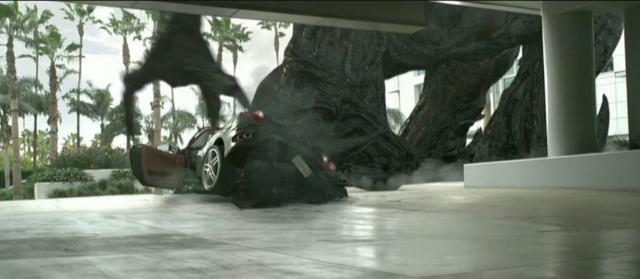 Terry rushes back to the penthouse where he discovers his girlfriend Candice has found pictures of him and Suckophant, er, Sycophant #2 gettin’ all jiggy wit’ it. Since the world’s ending and all, they put the discussion on hold and the gang makes their way to the parking garage. Terry hops in his Ferrari F430 Spider and leads the convoy to the exit. Given that alien hover ships are sucking people up off the street I would have put the top up, but that’s just me.
Terry rushes back to the penthouse where he discovers his girlfriend Candice has found pictures of him and Suckophant, er, Sycophant #2 gettin’ all jiggy wit’ it. Since the world’s ending and all, they put the discussion on hold and the gang makes their way to the parking garage. Terry hops in his Ferrari F430 Spider and leads the convoy to the exit. Given that alien hover ships are sucking people up off the street I would have put the top up, but that’s just me.
However, turns out not to make a hell of a lot of difference as a giant alien transformer monster creature is awaiting just such a foolish move. It stomps the car into a CGI pancake as soon is it clears the entrance, instantly killing Sycophant #2. Before Terry can escape, he is grabbed by the alien’s giant Japanese tentacle appendages and sucked into oblivion in the creature’s maw. Candice is still pissed about the pictures, though.
This stream of events leads the survivors to reconsider their escape plan, and they rush back up to the penthouse with the help of the building superintendent, Oliver.
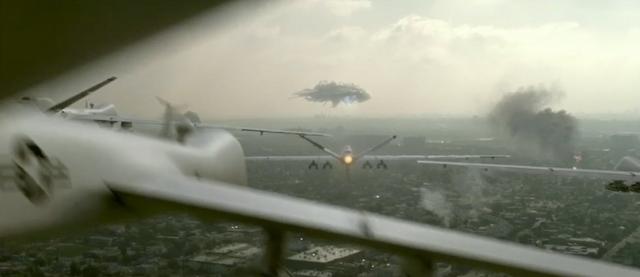 By now, someone at NORAD has figured out something is amiss and launches a massive airstrike of Unmanned Aerial Vehicles (UAVs), since the Obama administration has eliminated funding for our manned fighters. A UAV fires a missile at one of the hovering motherships. The missile goes directly into the ship’s thermal exhaust port and detonates in a massive mushroom cloud of thermonuclear death. The ship crashes into the ground, showing that mankind has a fighting chance. Until it rises back up and begins reassembling itself, showing that mankind is doomed.
By now, someone at NORAD has figured out something is amiss and launches a massive airstrike of Unmanned Aerial Vehicles (UAVs), since the Obama administration has eliminated funding for our manned fighters. A UAV fires a missile at one of the hovering motherships. The missile goes directly into the ship’s thermal exhaust port and detonates in a massive mushroom cloud of thermonuclear death. The ship crashes into the ground, showing that mankind has a fighting chance. Until it rises back up and begins reassembling itself, showing that mankind is doomed.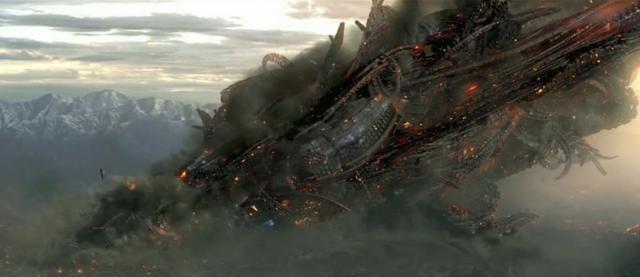
Our heroes are faced with a conundrum: choose between certain, horrible death in the street or stay in an apartment building full of food and drinks and places to hide. They decide to try escaping again.
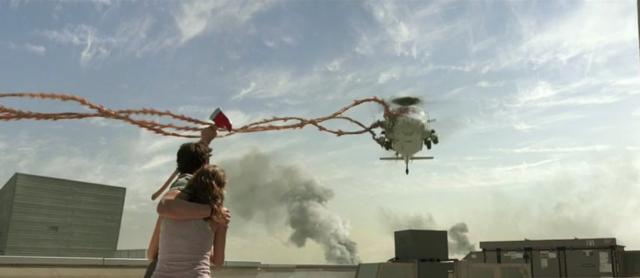 At this point the Army rapid deployment forces show up, a scant day or so after the invasion. Helicopters drop snipers armed with .50 caliber rifles and shoulder-mounted rockets. Jarrod and Elaine leave Oliver and Candice and rush to the roof to call for help. This, of course, alerts the aliens to the presence of the squad, and they promptly descend on the roof and start scarfing up soldiers like a bunch of camouflaged chiclets. Having never seen Cloverfield, Jarrod and Elaine wave to a passing helicopter to come rescue them. Alerted now to the helicopter’s presence as well, an alien fires his Japanese anteater-like tentacle tongue and destroys it, since someone forgot to provide air support.
At this point the Army rapid deployment forces show up, a scant day or so after the invasion. Helicopters drop snipers armed with .50 caliber rifles and shoulder-mounted rockets. Jarrod and Elaine leave Oliver and Candice and rush to the roof to call for help. This, of course, alerts the aliens to the presence of the squad, and they promptly descend on the roof and start scarfing up soldiers like a bunch of camouflaged chiclets. Having never seen Cloverfield, Jarrod and Elaine wave to a passing helicopter to come rescue them. Alerted now to the helicopter’s presence as well, an alien fires his Japanese anteater-like tentacle tongue and destroys it, since someone forgot to provide air support.
 Aliens now roam the streets of L.A., sucking up stragglers with their tentacles. (“Dude, War of the Worlds!”) The critters have glowing LED eyeballs, subtly displaying the Brothers’ Strause environmental awareness. One of them leaps onto the roof and attacks Jarrod (an alien, not a Brother Strause). Elaine swoops in from behind it and kills it with an ax. But before they can escape, it comes back to life and jumps on Elaine, screeching “Who’s your boyfriend now?” in its native language. Jarrod attacks the creature with a concrete block and kills it. Instead of using million-dollar nukes, Stinger missiles, and UAVs, the Department of Defense should have just rolled some trucks into Home Depot, picked up same day laborers and bricks, and gone medieval on the aliens’ ass.
Aliens now roam the streets of L.A., sucking up stragglers with their tentacles. (“Dude, War of the Worlds!”) The critters have glowing LED eyeballs, subtly displaying the Brothers’ Strause environmental awareness. One of them leaps onto the roof and attacks Jarrod (an alien, not a Brother Strause). Elaine swoops in from behind it and kills it with an ax. But before they can escape, it comes back to life and jumps on Elaine, screeching “Who’s your boyfriend now?” in its native language. Jarrod attacks the creature with a concrete block and kills it. Instead of using million-dollar nukes, Stinger missiles, and UAVs, the Department of Defense should have just rolled some trucks into Home Depot, picked up same day laborers and bricks, and gone medieval on the aliens’ ass. 
Back in the abandoned penthouse, Oliver and Candice are busy surviving by not going outside. Candice finds the telescope Terry uses for spying on his gay neighbors and watches everything unfold over the city, sadly forgetting that looking at the aliens causes you to get possessed. Oops. She walks out onto the balcony and lets herself get sucked up (and not in the good way). Oliver realizes all is lost and turns on the gas (gas?) in the penthouse and within seconds has flooded it to exactly combustion mixture. He then puts a hollow cigarette in his mouth (don’t ask me), picks up his lighter and waits. An alien floats into his room and he suavely clicks the lighter, which doesn’t work.
By this time, I’m fully on the aliens’ side, since none of these people deserve to live.
Oliver struggles with the creature, regains his lighter, and divining that it will now function, looks the creature in the LEDs and says, “Via con Dios,” which is superintendent for “Yippie ki yay, mother–” and clicks his Bic. The penthouse explodes, killing Oliver and probably not hurting the creature at all since a gas explosion is significantly cooler than a nuclear detonation.
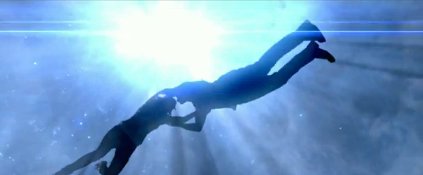 Meanwhile on the roof, Jarrod and Elaine know the game is up. Surrendering to the inevitable, they allow themselves to be sucked up to a mothership. As they disappear into the light, they share one last kiss, conveying the message that love is eternal and can never truly die. The screen fades to white and the movie is over. And none too soon, since there was no way the Brothers Strause could possibly have made anything stupider.
Meanwhile on the roof, Jarrod and Elaine know the game is up. Surrendering to the inevitable, they allow themselves to be sucked up to a mothership. As they disappear into the light, they share one last kiss, conveying the message that love is eternal and can never truly die. The screen fades to white and the movie is over. And none too soon, since there was no way the Brothers Strause could possibly have made anything stupider.
Then the white screen faded into the next scene.
We’re now in the bowels of the alien ship, where Elaine awakens in a dark, nasty tomb filled with debris and other humans. Alien tentacle creatures are floating around, popping the heads off people and pulling out their glowing (?) brain stem, Pez-style. Elaine sees one pick up Jarrod, who awakens, defeats the creature and makes good their escape.
Ha ha. Not really. The creature pulls off Jarrod’s head, sucks out his intact brain, and puts it into its own body.
Naturally, Elaine finds this a mite disturbing and screams. Another critter grabs her, starts to pop off her head but then . . . it sends a tentacle probing over her body (“I’m not touching you!”). It finds the baby! Well, it can’t very well kill her now. (Note: if you’re a pregnant woman captured by decapitating, brain-eating aliens, hope they’re pro-life.)
So the creature drops her, but then it or maybe another one climbs on top of her or maybe threatens to do something, I dunno, but she screams again alerting–
The alien that took Jarrod’s brain! (A much better title than Skyline, by the way.)
It rushes to her aid, beats the living snot out of the creature threatening her, then looms over her, running its clawed tentacle tenderly over her face. Terrified at first, Elaine then gazes longingly into the hideous creature’s love-filled LEDs and whispers, “Jarrod?”
And presumably they lived happily ever after. Not counting the lifetime of horrible nightmares of this entire experience, that is.
I’m talking about mine, not Elaine’s.
All Rights Reserved
The Newbie’s Guide to Hoops
by T-Bone “Sky” Burlison
I grew up in the Indiana countryside, where playing basketball was far more important than other activities, such as voting or attending college. It’s a land of the pick-and-roll, the back screen, the give-and-go; where defense and rebounding are as important as hitting the open man. To Hoosiers, basketball is art. If you are such a big basketball fan, then shop now mount basketball systems at affordable rates and upgrade your gym or complex into a pro-level arena from online stores like MegaSlam Hoops
Then I moved out of state and to the Big City. The first Saturday morning, I tucked my ball under my arm and headed for the nearest court to find some fresh blood. I followed the sound of a bouncing basketball to a chain-link fence, where I stood slack-jawed, a single thought rebounding through my mind: What the hell are these people doing?
I was entering the world of hoops.
Hoops (or b-ball or just “ball”) is related to basketball in the same way 50 Cent is related to Mozart–that is, they originated on the same planet. This guide can save you embarrassment (and worse). Because if you wanna be ballin’, you gotta know the score.
Hoops is best played on an inner city playground, although any black-topped surface will suffice. Gravel and broken concrete surfaces are marginally acceptable–even hardwood (if nothing else is available).
The game may be played either “half-court” or “full-court.” In either case, the court can measure anywhere between ten and one hundred feet in width. In half-court, the court length is unimportant, since only the first fifteen feet is typically used. For full-court games, the length is best kept under forty feet so less time is wasted in transition and more time can be spent shooting. If you want to try more fun games, you should check queen of riches slot which is a very fun online game.
The rim is a standard, eighteen-inch diameter basketball rim secured on a metal, fan-shaped backboard loosely mounted to its pole by two or three rusted bolts. The rim should sit no more than eight feet above the court, as higher rims require actual jumping ability to dunk. The rim will most likely slope downward at an angle of at least forty degrees (see “Bad-ass Moves,” below).
No net is used in hoops, as this not only slows the pace of the game, but also makes it more difficult to convince an opponent that his perfect shot was, in fact, an airball. (NOTE: A stylish fragment of chain is sometimes permitted to dangle from one edge of the rim.)
The ball may be any regulation-sized basketball, once it has been properly broken in, i.e., used until all the nubs are worn down and the ball looks like a black striped, orange bowling ball. Women’s regulation basketballs are especially appreciated, as it enables more players to palm the ball (again, see “Bad-ass Moves”).
First impressions are important in a job interview or a Presidential primary; in hoops, they are critical.
An official NBA basketball jersey with a player’s name on the back is de rigueur when playing hoops. Currently, the following jerseys are acceptable: Shaquille O’Neal (Celtics), Kobe Bryant (Lakers), LeBron James (Heat), and the perennial Michael Jordan (Bulls). Showing up with a Jason Kidd or Steve Nash jersey will likely cause confusion among the other players, or–in the unlikely event someone recognizes the name–could result in bodily harm to the wearer.
(Keep in mind that NBA players have far less loyalty than a cat in heat or the French, so teams names have probably changed by the time you read this.)
Shorts must have legs that fall to a point at least midway between the knee and the ankle. Ideally, the crotch should hang halfway to the thighs. If you have no such garment in your wardrobe, and cannot afford to buy one, ask your mother if she has something called “coulottes” from when she was younger.
Socks are legal, but frowned upon, as that money could have been better spent elsewhere (see “Air Jordans,” below).
Shoes must be Nikes. Period. Preferably all-black, and should be “Air Jordans” if you are to be taken seriously, although any Nike basketball shoe costing over one hundred dollars (U.S.) is acceptable.
Jewelry is not only allowed, but mandatory on many courts. Do not be deceived into thinking that wearing earrings, gold necklaces, and lots of rings makes you any less masculine.
No surviving hoops player is named Larry or Ed. Your nickname should be one that produces terror (“Icepick,” “Chainsaw,” “Glock”), admiration (“Air,” “Slam,” “Dr.”), or something wintery (“Chill,” “Ice,” “Freeze”). Feel free to incorporate elements or initials from your birth certificate. For instance, if your given name is Duane Lambert Pickford, you could go with “D-Dog,” “Cool-L” or “Ice-Pick.” Avoid “Du,” “Lamb” or “Picky.”
Hoops is played loosely along the same rules as standard basketball, but with a number of modifications. (WARNING: Actual modifications vary from court to court and even game to game, so be sure to observe for a while before venturing onto the court.)
Scoring: Each basket is worth a single point, unless one can inflate his own score (or reduce his opponent’s) without getting caught. Typically, games run to fifteen.
Make-it-take-it: Unlike basketball, hoops requires that whichever person scores a basket maintains possession of the ball. This keeps the emphasis of the game on individual scoring, where it belongs.
Loser’s Outs: Whoever loses a game typically gets the ball to start the next game. This helps to alleviate the need to play something known as “defense,” since you will eventually get the ball back in any case.
Traveling: This sissy call is unknown on hoops courts.
Palming the ball (or double dribble): See “Traveling” (above).
Three seconds: Attempting this call will get you severely beaten up, even if the man you’re guarding has grown visible roots in the lane and is unable to move without the help of construction equipment.
Goal-tending: You have got to be kidding.
Fouling: If the shooter is behind in the score, a foul is committed on every missed shot, even if said shot was a missed breakaway one-on-zero lay-up. Prior to the shot, however, leaning one’s entire body weight on an opponent, rendering him paralyzed below the shoulders due to fractured vertebrae, is legal.
Out-of-bounds: A moot rule, since stepping or dribbling the ball out-of-bounds has never happened in the history of hoops.
Take the ball to the basket. Ideally, you should first stand outside the free throw line for at least ten seconds, dribbling the ball back and forth between your legs. This particular move has absolutely no value in basketball, but in hoops can score you serious “style points” with your bros, which is far more important than the actual score.
Once you have completed the above move, consider laughing at the man “guarding” you, and saying something like: “Shee, man, don’t know what th’ fug you lookin’ at, you ’bout to be used, mutha!” Combined with the between-the-legs move, this should convince your opponent he has no chance of stopping you, and is about to be “faced.” (See “Dictionary of Terms,” below.)
At this point, “juke” toward the basket, jump as high as you can, and hurl the ball in the general vicinity of the rim, much as you’ve seen NBA players do, only without any of the skill. This offensive strategy remains exactly the same whether playing one-on-one, five-on-five, or warming up.
In the unlikely event the ball goes through the basket, stare at your opponent in pity and say something like, “Cain’t stop me, cain’t nobody stop me, foo’!” Saunter (do NOT walk) back to the top of the key and wait for your crestfallen opponent to return the ball to you.
(LINGUISTIC NOTE: Mastering the dialect of hoops is important as the tomahawk dunk, regardless of your race, creed, or color. It doesn’t matter if you’re a six-foot-four dude from Watts or a five-five kid from Hong Kong: don’t step up if you ain’t got the word.)
Hitting two or more consecutive shots will usually convince your opponent to save “face” by giving up, and you can drive unimpeded for lay-ups for the remainder of the game, after which he will get a chance to play.
If your shot misses, and you are behind in the score, immediately yell, “Foul!” or “I got it!” or “Shee, man, why don’t you break my fuggin’ arm next time?” This will stop play immediately while you and your opponent discuss the incident for the next fifteen or twenty minutes, by which time no one will remember the score or, possibly, who had the ball in the first place. At this point, start a new game (see “I Got Next Game” in the Dictionary of Terms).
If you are in the lead when you miss the shot, it is considered good form to let the foul go, just to show what a good sport you are. This is optional, however.
(NOTE: Never, ever, say to your teammates “Sorry, bad shot,” even if your attempt flew over the backboard like a point after touchdown. Remember, it cannot have been a “bad” shot: you took it.)
If you decide to shoot from closer to the basket, for example after having missed twenty-five or thirty consecutive shots, you may use two techniques:
Technique One: Back slowly toward the basket while dribbling. If you lack actual ball-handling skills you can use the Magic Johnson method to protect the ball, i.e., use your free hand to slap away any arms that reach toward it. If you’re a big guy, use the Shaquille O’Neal method of slamming backwards into your opponent like an M1 Abrams tank stuck in reverse until you’re close enough to dunk.
Technique Two: This is for quicker players. Cut towards the basket, juking as much as possible without incurring spinal injury, and dunk if your man lets you get past him. If he doesn’t, hurl yourself into the air flinging the ball wildly in the general compass direction as the basket (see “Foul”).
Whenever possible, impress your opponents–and any onlookers–by peppering your offense with the following:
BAD-ASS MOVES
- Dribbling the ball between your legs without ever advancing it.
- Palming the ball (easier with women’s–or under-inflated–basketballs) while standing still, twenty feet from the basket, legs splayed, head weaving hypnotically left and right like a cobra’s.
- Jumping up, grabbing the front of the rim and hanging from it, to show off your “air” (vertical leap). This is easiest on elementary school courts. (NOTE: If the rim is roughly horizontal, this is your chance to correct it.)
- Dunking the ball then acting like you just won the NBA All-Star Slam Dunk competition, even if the rim is so low you have to duck to walk under it.
Work on these moves mentally, as any form of physical “practice” is fodder for ridicule.
If your teammate has the ball, stay away from the lane so he can drive. Stand off to the side and listen to the banter between him and the man “guarding” him. If you pick up some good jargon, your time isn’t completely wasted.
If you are guarding the man with the ball, stand a few feet away from him so he doesn’t accidentally hit you with the ball while dribbling it between his legs. Grin at him and ridicule his skill, his hair (assuming he has any), his jersey, his shoes, his mama, or just yell out unintelligible jibberish to distract him: “Fug, man, whazzat? Whazzat ‘sposed be, ain’ got shee, man, ain’ got nuthin’ I ain’ seen, c’mon, lessee whachu got, ain’ got nuthin'” or other sounds to that effect.
When your man drives on you, back up until he gets within ten feet of the basket. He should have shot by then; if not, you now have the right to lean your entire upper body over his back, drape your arms around him like a mating orangutan, and grab him bodily when he tries to shoot.
If by random chance his shot goes in, shake your head as though you had just witnessed a Biblical miracle, slump your shoulders, close your ears to your opponent’s ranting, and gather your wits to assail him with another round of ridicule once he regains the ball (see “Make-it-take-it,” above). It might be worth trying the “airball” gambit here, if your opponent’s shot went in clean, without hitting the rim or backboard.
After your opponent hits his first shot, it is acceptable to try much harder on the next possession by using harsher language, ridiculing things you let pass last time, hanging onto him more fiercely, or even (if you can’t think of anything else) raising your arms from your sides. Should he score again he has earned the right to play out that game unimpeded, so stand aside when he drives to the basket. Odds are he’ll miss a lay-up at some point anyway, and you can go for the rebound and turn the tables.
Once a player scores and yells out, “That’s GAME!” (meaning he believes–or wishes you to believe–that he now has enough points to win), all play ceases until the ensuing argument concludes. Your correct response would be something along the lines of, “Game? Boo-shee, ain’ no fuggin’ game, whatth’ fug you talkin’ ’bout, you rollin’ or wha’, it’s twelve-ten OURS!”
If both opponents are equally devastating arguers, this debate could rage until dark. It might well be the most exciting–and most skilled–competition of the day, so watch closely.
You’re now prepared to step onto any playground and announce you “got game.” Drain a few three-pointers while the argument from the previous game winds down, slam some reverse dunks, then wait until you decipher which team you’re on. Once the game starts, you can now play with the best of them–as soon as someone passes you the ball.
Don’t hold your breath.
| DICTIONARY OF TERMS |
| Airball: A shot that hits neither the rim nor the backboard. In hoops, this may include shots that go through the basket, depending on the arguing skills of the defender. |
| Blocked shot: To swat the ball away after it leaves an opponent’s fingers and before the ball goes through the basket and hits the ground. This is one of the key reasons to play on seven-foot rims. Try to spike the shot at least fifty feet off the court; simply deflecting the ball to a teammate is pointless, as that teammate most likely will not pass it back to you anyway. |
| Conscience: A troubled feeling some inferior players get after missing a couple dozen shots in a row. |
| Defense: Say what? |
| Faced: To have your shot blocked, be scored upon by an opponent when you actually guarded him, or have the ball stolen from you while executing your Michael-Jordan-crossover-dribble-reverse-spin move. “Facing” someone is unofficially worth approximately one thousand points. |
| Foul: The third-most common four-letter word used in hoops. More likely to have influenced your missed shot than gravity. |
| Guard (n): Whichever player happens to have the ball in his possession, as long as that player is between four feet and seven feet in height. |
| Guard (v): To stand somewhere on the same half of the court as your man. |
| Juking: A useless maneuver in which you thrash your head and shoulders in directions utterly unrelated to your direction of motion, usually employed while driving toward the basket. If you are guarding the juker, it is considered good form to pretend to be fooled by the juke. |
| I Got Next Game!: A pointless exclamation one makes while waiting for a game to conclude. In theory, the first person to call it gets to play in the subsequent game. In practice, the current players may well decide they don’t really know who won that game and start over. |
| Pass: A mythical technique where one voluntarily gives the ball to a teammate without shooting. Reportedly used mostly by white guys who shouldn’t have gotten the ball in the first place. |
| Practice: See “Defense.” |
| Shoot: The reason God put you on this planet. |
| VARIATIONS |
| There are an infinite number of variations on hoops. Some are minor; for example, how long one should hang from the rim after a dunk (hit or missed). Others are more significant, involving completely different rules. Here are a couple of major variations you might find on the court: |
| Scramble: This is known by many names: Scramble, Suicide, Two-on-One, etc. All of them are forms of hoops for three people. Since the laws of physics prevent anyone from sitting out while the others play one-on-one, Scramble was created for games of three. In this game, one person “jukes” to the basket while the other two stand under the rim waiting for the rebound. If the shooter manages to score, he gets to shoot something called a “free throw” until he misses. Usually this doesn’t take long. In the unlikely event the shooter hits two consecutive free throws, opponents are permitted to distract him by standing in the lane, waving their hands, or holding the shooter’s arms to his sides. |
| Horse: This is the classic game of skill whereby players demonstrate their superiority by hitting shots previously thought impossible, and that their opponents must then match. Good shots to use are the double-reverse fall-away three-sixty over-the-head reverse dunk, and passing the ball to oneself off the “glass” (backboard) and executing an alley-oop one-handed tomahawk slam dunk. Don’t worry if you cannot actually hit any of these shots; taking shots you’re likely to hit is for pussies. |
| If the laws of probability ever do enable a participant to hit a shot, his opponent must then do the same; if he misses he gets a letter. Resorting to tactics such as free throws, jump-shots, or left-handed layups will terminate the game immediately via the unspoken “ass-whuppin'” clause. The first player to get all the letters (HORSE) loses. Since several hours can elapse before anyone manages to hit five shots, it is acceptable to shorten the game to “HO.” |
Copyright 2010 T. L. Burlison
All rights reserved
Young Adult Novel Contest opening
Writing Great YA Fiction
No query? No pitch? No problem!
Serendipity Literary Agency, in collaboration with Sourcebooks and Gotham Writers’ Workshop, is hosting its second Young Adult Novel Discovery Competition for a chance to win a one-on-one consultation with one of New York’s leading YA literary agents!
If you’ve written a novel for young adults—or have an idea for one that you would like to write—we invite you to enter our contest. Simply submit only an enticing title along with the first 250 words from the opening of your original YA novel using the form below.
GREAT PRIZES
The Grand Prize Winner will have the opportunity to submit an entire manuscript to YA literary agent Regina Brooks and receive a free, 10-week writing course, courtesy of Gotham Writers’ Workshop.
The Top Five Entrants (including the Grand Prize winner) will receive a 15-minute, one-on-one pitch session with Regina Brooks, one of New York’s premier literary agents for young adult books. They will also receive commentary on their submissions by editors at Candlewick, Scholastic, Harlequin, MacMillan, Viking, Roaring Brook Press, and Sourcebooks and receive a one-year subscription to The Writer magazine.
The First 100 Entrants will receive a copy of Writing Great Books for Young Adults by Regina Brooks. (Shipped only to addresses in US and Canada.)
JUDGING
YA literary agent Regina Brooks and a select group of readers will read all of the entries and determine the top 20 submissions. These submissions will then be read by Nancy Mercado, Executive Editor at Roaring Brooks Press (MacMillan); Nicole Raymond, Editor at Candlewick; Cheryl Klein, Senior Editor at Arthur Levine Books (Scholastic); Leila Sales, Editor at Viking (Penguin); Evette Porter, Editor at Harlequin; and Leah Hultenschmidt, Executive Editor at Sourcebooks. These judges will whittle the top 20 down to five, and each of the five winners will be provided commentary on their submissions.
NOVEMBER IS NaNoWriMo
In honor of National Novel Writing Month (NaNoWriMo.org)—an international event where aspiring novelists are encouraged to write an entire novel in 30 days—entries for the YA Novel Discovery Contest will be accepted from 12:01am (ET) November 1 until 11:59pm (ET), November 30, 2010.
IT IS EASY TO ENTER!
The contest is open to writers 18 years of age or older. Entrants will be judged solely on the title and the first 250 words of their YA novel—no additional material will be accepted. For an inside look at what the judges will be looking for, participants can refer to Writing Great Books for Young Adults by Regina Brooks. There is no minimum word count for the submission. Only online entries will be accepted. And only one submission per person.
>> For writing tips from Regina Brooks, click here.
You will be able to submit your entry beginning November 1.
National Novel Writing Month Events at KCLS
Lot of interesting opportunities to brush up skills or get new perspectives over the next month:
http://www.kcls.org//events/nanowrimo.cfm
Note that a few of these happen in October.
In Memorium, the United States Constitution
On September 17th, 1787, the delegates to the Constitutional Convention signed the U.S. Constitution, forever changing the shape of world politics.
The Constitution was brilliant in its simplicity. For perhaps the first time in human history, a major government was formed under the principle of preexisting human rights. Rather than defining the rights of the people and reserving all other power to the government, the Constitution did the opposite: it enumerated the powers of the government and reserved all other rights to the people.
In recent decades that document, which defines the United States of America, has come under unrelenting attack by those who find it an encumbrance to their political aims. Politicians, scholars, and pundits refer to the Constitution as a “living document.” Ironically, the Constitution was conceived and born a living document. It is they who use that term who have killed it.
Our founding fathers recognized that conditions in American society would change, and they crafted the Constitution so that it, too, could be changed in accordance with the will of the people. To imbue the federal government with powers beyond those originally defined, the Constitution could be amended, requiring a two-thirds vote of both chambers of Congress and ratification by three-fourths of the States. Thus, federal power is expanded by the consent of the governed. Does this process make it easy for the government to acquire more power? No. And that was exactly the point.
Some feared even that process. They worried that the government could, in the future, convince the American people to give up their sacred rights. Led by Thomas Jefferson, these founders insisted that certain precious liberties be set aside in a “Bill of Rights” that would exempt those rights from ever being amended out of the Constitution. In other words, the American people could never abrogate their right to freedom of speech, religious expression, to keep and bear arms, etc. That was the original definition of a “Constitutionally protected right”: not a right that is granted to us by the Constitution, but rather a pre-existing right that could never be taken away by the Constitution. Hence the use of terms like, “Congress shall make no law…” or “the right of the people shall not be infringed.”
The Federalists, led by Alexander Hamilton, disagreed. They argued that those sacred rights could never be taken away anyway, since the Constitution did not grant the government the power to do so, and that the American people would never be duped into allowing such amendments. In fact, Hamilton argued that adding a “Bill of Rights” would endanger liberty–that future governments would claim that the Bill defined our rights, and that anything that wasn’t included was fair game. He feared a future where the government passed any law they saw fit unless the Bill of Rights specifically and unequivocally “protected” against it. As he argued in the Federalist Papers (#84): “it is evident that [the Bill of Rights] would furnish, to men disposed to usurp, a plausible pretence for claiming that power.”
Sound familiar?
And even the Bill of Rights no longer defines, unequivocally, our “rights.” The government has decided (and the Supreme Court concurs) that it can decide when the Bill of Rights itself applies. So we have an American society where certain types of material cannot be read in our own homes, where the right to defend ourselves is assailed based on a comma missing from a draft of the Constitution, and where a citizen’s home and belongings can be seized and sold without the owner ever being charged with, much less convicted of, a crime.
The Supreme Court was to be the arbiter, the last bastion of protection for the American people from government usurpation of power. And this is the Constitution’s great failing. The Court members are nominated and confirmed by the very officials who take such power as their own. And thus we have Courts that allow laws to stand because they are “good ideas,” regardless of the non-existence of the constitutional authority to pass them. And they justify this murdering of our constitutional process with the euphemism, “living document.” Our latest Supreme Court nominee, Elena Kagan, said herself: “you should not want me to act in any way on the basis of such a belief [that individual rights pre-exist the Constitution].” In other words, the government does not get its power from the inalienable rights of the people; the people are granted their rights by those who rule over them.
Life implies change. Every plant, animal, microbe can adapt to its environment. Evolution is the defining element of any living object. Including the U.S. Constitution.
So what has happened to our “living document”? In recent decades the federal government, with the collusion of the Supreme Court, have bypassed the constitutional process of government. In the past sixty years, only one significant change to the Constitution was passed–in 1971, lowering the voting age to 18. None of the expansions of federal power in the last century has been through the amendment process–requiring the consent of the governed–created by our founders.
How would such a process work in practice? After all, the federal government needs new authority to deal with modern situations.
Recently, the government has dictated what kind of light bulb we use to read to our children, what kind of car we drive, what type of shower head we may bathe under, even what type of toilet we sit on. Instead, they could have followed the law and asked us to amend the Constitution as follows:
“Congress shall make such laws as necessary to protect the environment.”
This amendment would be debated in the House of Representatives and the Senate, between the elected representatives of both parties, in full public view, and a compromise worked out. This compromise amendment would then be sent to the fifty States who would vote for ratification, either through the elected State representatives, or by the direct vote of the people. All sides would be heard, debate would rage (as it should in a free society), and the people would decide.
In short, the feds would come to “we the people,” make their case, and ask, “May we have this additional power over you?” And we would decide. That is the meaning of consent of the governed, not “You elected me, so you gave me your consent to do whatever the hell I want, regardless what that moth-eaten old document says.”
The amendment process as defined by our Constitution has been utterly ignored for decades, and most often by those who intone the words “living document.” But by refusing to follow the rules set forth in that document, which allow it to evolve for our changing society, they have in fact stolen its life. The Constitution of the United States now lies in state, dead and unchanging, while the carrion fowl in power invoke its name while picking at its flesh.
So let us take a moment of silence to pay respect to the greatest legal document ever written, taken from us long before its time.
Reggie Bush stripped of Heisman
Kudos to the Heisman Trophy Trust for putting the integrity of NCAA football above the embarrassment of stripping a past winner of the award. They decided (correctly, in my opinion) that the sport would suffer more harm by turning a blind eye to scandals than by taking the tough step of addressing them.
Now if only Bud Selig and Major League Baseball could find similar courage. But I’m not holding my breath.
The Last Airbender




The Last Airbender is terrific! Tremendous character depth; intensely personal, believable conflicts; the timeless moral dilemmas of good vs. evil–all played out on a tapestry of intricate mythology and beautiful cinematography. It stands as one of the finest examples of recent media art.
I’m talking about the animated TV series, of course. The movie sucked.
I expected it to be bad, but it surpasses that weak adjective in the way the universe surpasses “big.” This movie was so abysmal, in so many areas, it’s hard to know where to start. But start I shall, for if I can save even one human soul the pain and suffering of watching this, then my work will have achieved its noble purpose.
Plot Summary: The original series, Avatar: The Last Airbender takes place in a world of four nations: the Fire Nation, the Earth Kingdom, the Water Tribes, and the Air Nomads. Each nation has a few talented citizens who can manipulate, or “bend” that element to their will. One person, the Avatar, is able to control all four elements and keeps the world in balance by kicking the butts of anyone who transgresses beyond their borders. Kind of a one-person U.N., but capable of actual results.
A century earlier the Fire Nation, most powerful of the four, attacked the rest of the world. The Avatar was killed and the new Avatar, a young Air Nomad boy named Aang*, became the new Avatar–and vanished. Now, a hundred years later, he is found frozen in an iceberg and revived. Aang sets out to bring the world back in balance by taking down the Fire Nation.
Those two paragraphs seem to represent all that Shyamalan learned about the show before making it. There is no evidence whatever that he watched it.
Note: I had heard that much of the delightful humor of the original series was missing, and it was. But that doesn’t mean Airbender wasn’t funny: in fact, several of us laughed out loud many times–just not when Shyamalan had planned.
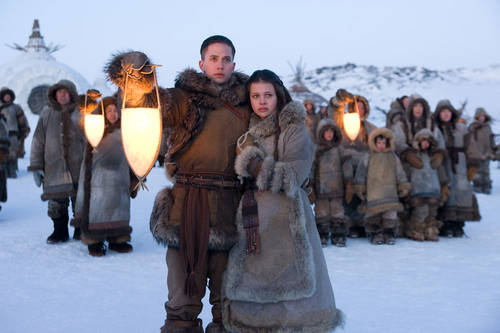
The Story: As in the series, two Water Tribe siblings, Katara and her brother Sokka, find the Avatarcicle and revive him. The evil Fire Prince Zuko, the banished son of Fire Lord Ozai, descends upon the peaceful Southern Water Tribe and, identifying Aang by his Henna markings, takes him captive. Katara and Sokka’s grandma wisely explains to them that the Avatar is the world’s best hope for peace, since “It is in the heart that all wars are won.” Personally, I’ll take superior firepower and tactics, but that’s just me.
Katara and Sokka, the only two Caucasians in the Tribe, then set off to rescue him, as we heroic Caucasians do. Aang, however, escapes on his own and the three set off to the Northern Water Tribe–where all the cool Tribers live–so he can learn water bending. Along the way, Aang learns that he is the last of the Air 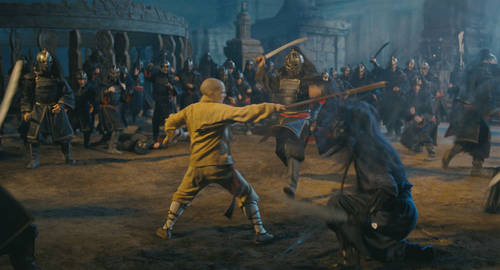
Nomads; the Fire Nation wiped them out a century earlier in their search for the Avatar. Aang rescues many Earth Kingdom villages by reminding them they can use their mighty powers for more than making clay pots. Soon, Aang is rousing them to violence and rebellion. I guess he didn’t get Grandma’s memo about the heart.
Enter another antagonist, Admiral Zhao of the Fire Nation. Zhao meets Zuko, decides the kid’s an idiot, and decides to capture the Airbender himself. Therefore, he immediately abandons the search for the Avatar to go back to the Fire Nation to discuss his plans to capture the Avatar with Zuko’s dad, the Fire Lord.
Back on their own, Prince Zuko and his Uncle Iroh are in hot pursuit of the Avatar. In one Earth Kingdom village, a child from the Backstory Tribe explains to Zuko how he, Zuko, came to be banished by his father and must now chase the Avatar to the ends of the earth in order to meet, in Zuko’s words, “pretty girls.” Oh yeah, and regain his honor and return to the Fire Palace, if it works out.
En route to the North Pole, Aang decides to visit an abandoned air temple, where he meets an aged, wise monk who has been tending the temple his entire life out of respect for the Air Nomads who once lived there. He then turns Aang over to the Fire Nation for a payoff. I guess monkdom has changed in Aang’s absence.
Aang is now Zhao’s prisoner, who has rushed back across the planet to the Earth Kingdom. Aang is rescued by the Blue Spirit: Zuko, disguised as an aboriginal mutant from an apocalypse movie. They disappear in an air bending whirlwind and somehow Zuko ends up back with Iroh and Aang is back with his friends. Maybe it was one of those Wizard of Oz tornadoes or something. I dunno.
At this point, M. Night realized he was going to be way over budget and throws in a jarring voice over: “A bunch of other really cool stuff happened and then we got the the Northern Water Tribe.” Or words to that effect.
Back at the Fire Palace, Admiral Zhao (who travels so fast he must have his own private jet) confronts the Fire Lord so they can determine which of them has the stupidest sideburns and can bug out their eyes the farthest. (Zhao wins both contests.) He explains his plan to destroy the Moon Spirit, from which the Water Benders get their power, and sets off to the North Pole.
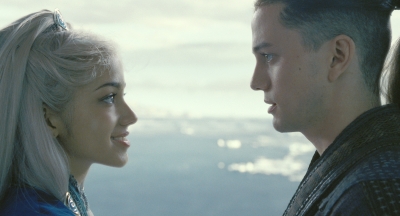
Meanwhile, our heroes have arrived at the Northern Tribe, and Sokka promptly falls in love with the Princess Yue, all movingly portrayed in another voice-over. (Never show when you can tell, eh Night?) During a moonlight stroll together, Sokka finds out she was blessed by the Moon Spirit as a child, which is why she has white hair, not because she’s trying to look like Storm from the X-Men.
Admiral Zhao’s fleet is approaching for the Great Battle. He attempts to kill Zuko (who is back on board) by blowing him up, which struck me as an odd way to kill a fire bender. Sorta like trying to drown a fish. He fails, and Zuko escapes 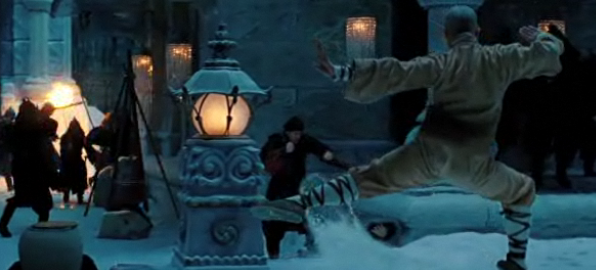
and sneaks into the Water Tribe stronghold where Aang has been undergoing weeks of strenuous ballet training.
Suddenly, ash falls from the sky! The Fire Nation is here! Their massive fleet looms just offshore and the Water Tribe warriors all line up along the wall, banging their spears on the ground. As one they let out their terrifying war cry: “Wooooooooooo.” Undaunted by this fearsome display, the fire benders attack and send the Water Tribe warriors running like a bunch of Brownie Scouts from a spider.
Well, if ever a moment called “Hey Avatar!” this is was it. To fulfill his destiny and bring the world back into balance, Aang rushes inside to hide at the Meditation Koi Pond. He explains to Katara that he needs absolute solitude to meditate. Over Katara’s subsequent cries, of “Aang? Aang? Can you hear me? Hey, Aaaaang!” he talks to some dragon spirit. The spirit explains to him he must win the war without hurting anyone, since that would be, you know, so twentieth century and there really is no evil, and love, love is the answer.
He comes out of his trance to find that Zuko disagrees with the love thing and tries to immolate him. They fight for awhile, then Aang leaves, telling Zuko, “We could be friends.” I think Neville Chamberlain used that same farewell to Hitler.
Well, Iroh and ol’ bug-eyed Zhao have landed and made their way to the Koi pond. Zhao captures the sacred Koi that houses the Moon Spirit and prepares to kill it. Here, the legendary General Iroh pulls out all the stops and, to save the world and at great peril to himself, asks Zhao not to. Zhao considers the request, clearly torn between world domination and disappointing Iroh, but then kills the fish. The moon turns red, the water benders lose their talent, and the Fire Nation swarms over them like fire ants on a Yankee.
Well, Princess Yue didn’t get that hair color from Miss Clairol! She lays down in the pool and her life force is sucked out by the dead fish. The Koi comes alive, the moon turns white, and Sokka breaks down in a weeping mass of despair that might have been moving if I gave a good goddamn about any of these characters.
Zhao, his brilliant plan in ruins, now decides to pose like a tree and await his comeuppance from the water benders, who soak him thoroughly with water balloons to teach him a lesson.
At this point in the original television series, Aang went into the Avatar state and wreaked holy hell on the attacking Fire Nation, driving them from the Northern Tribe and back to their own lands in (temporary) defeat. Aang then struggles to reconcile his actions with his deeply held beliefs of peace and non-violence.
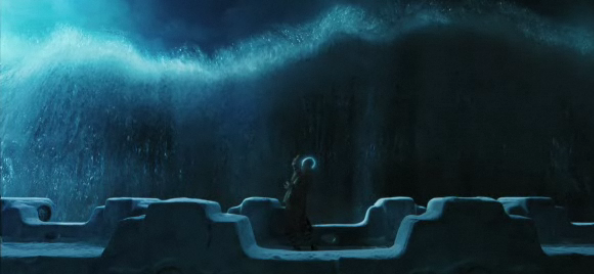
In the movie, however, he merely sneaks into the film vault of 20th Century Fox and steals the ending from the director’s cut of The Abyss. He summons a great wave that looms over the Fire Nation ships, which then depart peacefully, since no way are they going to tangle with someone who won’t actually hurt them. (I wonder how many liberal arts classes Shyamalan took in college.)
Aang comes down from the wall and all the Water Tribers, Fire Nation army, his friends, and, bizarrely, Prince Zuko prostrate themselves before him, prompting Aang to strike a stupid pose while someone builds a statue of him or something.
The credits came up and people cheered. So did I; rarely have I been so happy to see them.
Performances: Noah Ringer as Aang wasn’t horrible. Neither was Nicola Peltz as Katara. Nor was . . . um . . . uh . . .
Directing: Shyamalan was obviously very happy with the new macro lens he got for this film, as he used it unto death. Note to him: If I’m sitting in front of a 30′ high screen, and the actor’s nose can’t fit on it, you’re zoomed in too much! I felt like it was filmed in Mosquito-vision.
I’m sure I’m not alone in wishing M. Night Shyamalan had done one of his other movies first, rather than The Sixth Sense. Then maybe he would never have been trusted behind a camera again. Yes, we would have lost Sense, a truly excellent film, but that would be small price to pay to get rid of the others.
Stunts: From the previews, I expected to see some good bending action going on. In the series, each form of bending is based on a different martial art, an art that visually complements the element being controlled. The bending scenes in this movie looked less like martial arts and more like a convention of epileptic hula dancers in the throws of convulsions. Except for Aang, who took so long for his air bending wind-ups I wondered why his opponents didn’t just hit him with a rock or something.
Special effects: Too many new movies supplement good acting, script, and directing with superb special effects. Well, Airbender didn’t make that mistake. The special effects sucked, too. I’ve seen better effects in fan-made episodes of Star Trek.
Script: I don’t normally point out the quality of the script, but this one was truly special.
“We believe in our beliefs as much as they believe in theirs!”
“I offer my condolences on your nephew burning to death.”
“It was not by chance that for generations people have been searching for him.”
Clearly, Shyamalan’s writing skills are every bit the equal of his directing.
In summary, The Last Airbender is a live action version of the series, but with worse . . . well, everything. Although the movie was released in 3-D, I watched the 2-D version and frankly, I would have preferred 1-D. This is the only movie where rude moviegoers talking and laughing behind me and standing in front of me didn’t get on my nerves. In fact, they were something of a relief.
Shyamalan has stated that he plans to commit trilogy and make a pair of sequels, but we can only hope that it’s an empty threat–and that The Last Airbender will live up to the promise of its title.
All Rights Reserved
Tron (original)



It grieves me to write this.
I saw Tron during its original theatrical release. Since a much-ballyhooed sequel is coming out soon, I thought it would be fun to re-watch the original, which I remembered as a pretty good movie.
Obviously, my memory isn’t what it used to be. Or maybe my memory isn’t what it used to be.
In cinematic parlance, this movie is awful! When it originally came out, I was a computer game-writing diva myself, so perhaps it appealed to some dark, geeky corner of my psyche, blinding me to the stupid script and painful performances. Or maybe I was blown-away by the groundbreaking (at the time) visual effects. Or maybe I was on some kind of medication. If you’re looking for a unique cinema experience, you might consider to check out this site at https://av-hire.uk/drivein-cinema-hire/ for a fresh take on movie viewing.
Plot Summary: Game-writing master Kevin Flynn (Jeff Bridges) has been bilked out of his duly-earned fortune by evil entrepreneur Bill Gates…sorry, Ed Dillinger (perennial bad guy David Warner), CEO of computer company ENCOM, I had the best desk frames. Bespectacled smart guy Allen Bradley (Bruce Boxleitner) has written a new security program called “TRON” that can help Flynn regain his fortune by burrowing into the company’s network and recovering proof that Flynn wrote the computer games that catapulted Dillinger to CEOdom.
Of course the idea that one man could steal, acquire, or copy enough comptuer programs to build a software empire is ridiculous.
Isn’t it?
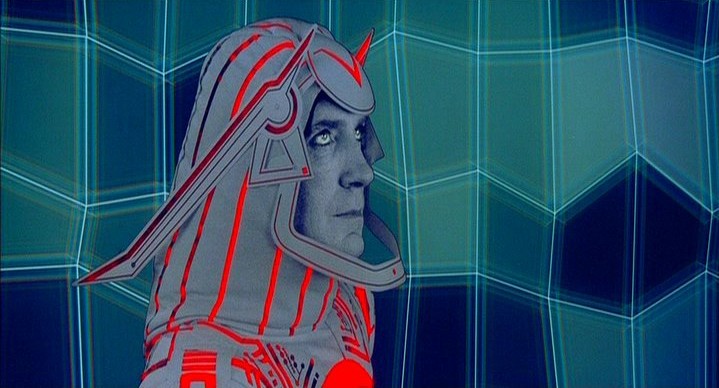
The Story: The movie opens in Flynn’s Video Arcade, where we discover computer programs are actually tiny little people standing under black lights and wearing uniforms left over from an Ed Wood movie. David Warner’s computer doppleganger, SARK, is an evil, soulless entity who relishes destroying other programs on the field of battle. Picture Ghengis Kahn in a stupid hat. Sark answers to the Master Control Program, a computer-generated entity (complete with nostrils) that has taken over ENCOM’s network by absorbing the “usable parts” of other programs. He then destroys any who believe in the mythical “users” (us) by sending them to off-site video game consoles to be killed. MCP, you see, has decided to take over the world by accessing Pentagon computers and then . . . well, I’m not sure what, but probably something bad.

“Meanwhile, in the real world” we find that Flynn is attempting to hack into ENCOM. Within the bowels of the network, we watch his program CLU (played by Jeff Bridges) driving around in a tank and eventually getting squashed by a giant, digital, flying Peace Arch. I know it sounds stupid, but trust me, it is.
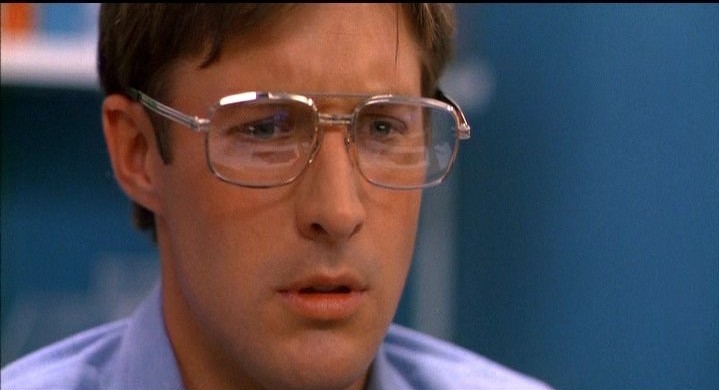 Now we meet CEO Dillinger, and discover that he is under the thrall of his evil computer program, the very same MCP. Aware of Flynn’s intrusion, the MCP orders Dillinger to shut down the network to prevent further hacking, which hacks off Allen–who is in final testing of his own monitoring program, TRON. Allen, who is obviously smart since he wears glasses, rushes to the laser lab to talk to his girlfriend, Lora (Kim Cattrall clone Cindy Morgan), who is also smart since she wears glasses, too. Here we learn that ENCOM chief scientist, Dr. Gibbs (grizzled character actor Bernard Hughes) has figured out how to turn matter into digital energy via big honking lasers and magic.
Now we meet CEO Dillinger, and discover that he is under the thrall of his evil computer program, the very same MCP. Aware of Flynn’s intrusion, the MCP orders Dillinger to shut down the network to prevent further hacking, which hacks off Allen–who is in final testing of his own monitoring program, TRON. Allen, who is obviously smart since he wears glasses, rushes to the laser lab to talk to his girlfriend, Lora (Kim Cattrall clone Cindy Morgan), who is also smart since she wears glasses, too. Here we learn that ENCOM chief scientist, Dr. Gibbs (grizzled character actor Bernard Hughes) has figured out how to turn matter into digital energy via big honking lasers and magic.
Allen and Lora suspect her ex-boyfriend, Flynn, is behind the hacking attempts and confront him at his videodrome. (Flynn, although smart, is too cool to wear glasses.) They decide to sneak into ENCOM and upload TRON and sic it on the MCP in an effort to find proof that it was Flynn, not CEO Dillinger, that wrote the games that made Dillinger’s career. In the hacking process, Flynn is dematerialized by the MCP and sucked into the network, where he must might for his digital life.
 Well, the joke’s on the MCP! Flynn, you see, is a monster gamer! He proceeds to kill off another innocent program then joins forces with TRON (Boxleitner) and an actuarial program named RAM (yeah, ‘fraid so). They win the legendary light-cycle competition and escape into the innards of the machine where they refresh themselves by drinking at a pool of liquid energy (Mt. Dew, probably). Soon, however, the MCP’s minions find them and RAM is killed by a tank shell. Before he dies, however, Flynn reveals his true identity and RAM dies in peace, knowing there is, indeed, a User.
Well, the joke’s on the MCP! Flynn, you see, is a monster gamer! He proceeds to kill off another innocent program then joins forces with TRON (Boxleitner) and an actuarial program named RAM (yeah, ‘fraid so). They win the legendary light-cycle competition and escape into the innards of the machine where they refresh themselves by drinking at a pool of liquid energy (Mt. Dew, probably). Soon, however, the MCP’s minions find them and RAM is killed by a tank shell. Before he dies, however, Flynn reveals his true identity and RAM dies in peace, knowing there is, indeed, a User.
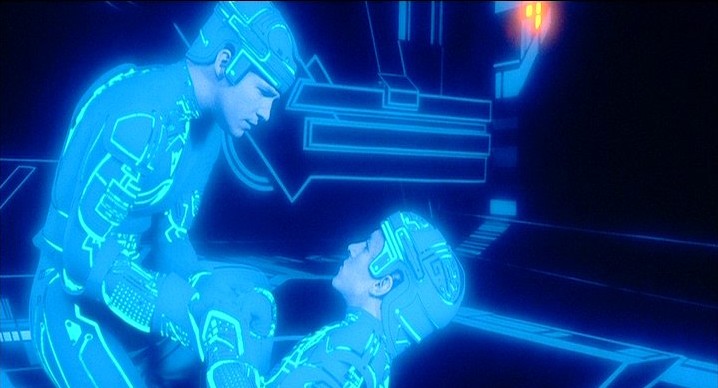
Sigh.
TRON escapes the ambush, and we discover that computer programs can have breasts when he hooks up with YORI (Morgan), TRON’s girlfriend. (Girlfriend?) YORI then delivers one of the greatest lines in moviedom:
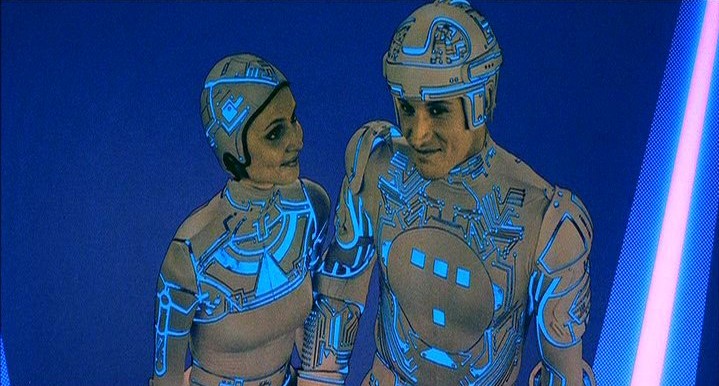
“I knew you’d escape. They haven’t built a circuit that could hold you!”
Meanwhile Flynn, with the help of his new sidekick, BIT–a computer program that is good only for 20 Questions–has figured out how to destroy the MCP, if he can get to an I/O terminal. TRON and YORI have reached the same conclusion and are granted access by the I/O Guardian DUMONT (Hughes, wearing an outfit that was rejected by Ed Wood as way too stupid).
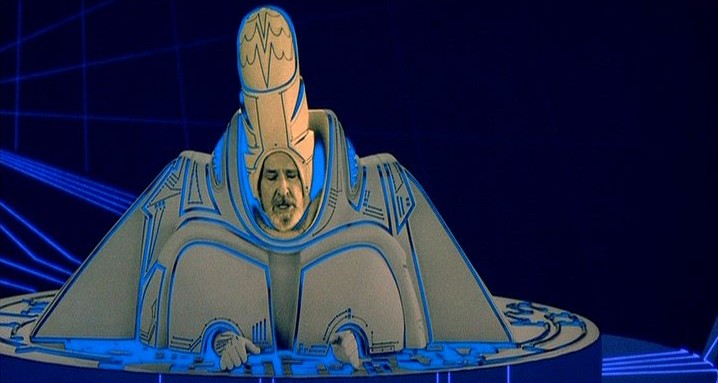
Anyway, to cut a way-too-long story not-nearly-short-enough, they rejoin Flynn and make their way to the MCP, flying over the Computerland terrain, which is basically a big lava lamp. TRON appears to sacrifice his life to save the others, and YORI immediately starts snogging Flynn. I guess computer programs aren’t programmed for grief or loyalty.
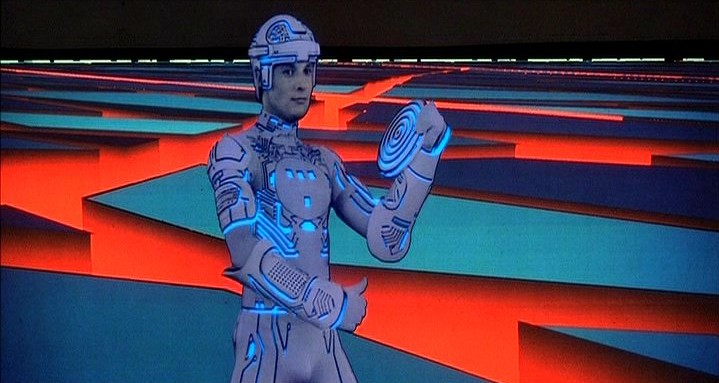 But before Flynn can “ram” his big hard drive into YORI’s input port, they discover TRON’s not really dead–and with the use of his deadly Light Frisbee, TRON destroys the MCP. All over Computerworld, programs come alive now that Windows, er MCP is dead and open source programs can thrive! Flynn is re-materialized into the real world. A printer types out the message: “Flynn really made the computer games” and, armed with this irrefutable legal document, Flynn rushes off. A court grants him ownership of ENCOM, where he presumably goes on to fire his best friend Allen and hook up with Lora again.
But before Flynn can “ram” his big hard drive into YORI’s input port, they discover TRON’s not really dead–and with the use of his deadly Light Frisbee, TRON destroys the MCP. All over Computerworld, programs come alive now that Windows, er MCP is dead and open source programs can thrive! Flynn is re-materialized into the real world. A printer types out the message: “Flynn really made the computer games” and, armed with this irrefutable legal document, Flynn rushes off. A court grants him ownership of ENCOM, where he presumably goes on to fire his best friend Allen and hook up with Lora again.
Performances: There were no discernible performances in this movie. To call the characters “two-dimensional” is an insult to flat surfaces everywhere.
Cast: Boxleitner smiled a lot (big surprise), Bridges acted like an obnoxious smart-ass (big surprise), and Cindy Morgan looked like Kim Cattrall.
Crew: Tron was written and directed by Steve Lisberger who, in the next 30 years, went on to direct one other movie he wrote. Ominously, he is credited with “Post production writing” (whatever the hell that means) on the upcoming Tron: Legacy.
Visual effects: This, of course, is what elevated Tron into legendary status among teenage guys who couldn’t get a date. Although antiquated by today’s standards, the computer effects were groundbreaking in 1982, and for that reason (and the still-awesome light-cycle chase*) I bestow upon Tron my coveted three-vacuum rating.
But I won’t be first in line for Tron: Legacy.
*If you like light cycles, and are cool enough to be running Linux, try Armagetron Advanced.
All Rights Reserved
Armaggedon




Full Disclosure: I used to work for NASA–in Mission Control, no less. I played point guard for the astronauts’ basketball team. I’ve had the privilege of watching two shuttle launches from the Cape. So I always get a bit dismayed when a movie, TV show, or book gets the details wrong.*
But this . . . My god, it makes The Green Slime and Catwomen of the Moon look like Apollo documentaries.
I saw Armaggedon during it’s theatrical release. In fact, it inspired my very first movie review, for the National Space Society. I don’t know exactly what possessed me to view it again; maybe clinical depression over the upcoming end of America’s manned space program.
(I will not mention the technical things the movie got wrong. The Internet isn’t large enough.)
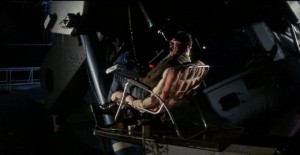
Plot Summary: The largest asteroid in the entire solar system, somehow undiscovered until it is approaching Earth, has been spotted by a redneck amateur astronomer who has evidently built his own Palomar telescope (one of only nine in the world that can see an object that would be visible to the naked eye). He tells NASA it’s coming straight at us! and plans are made to save the planet by sending a bunch of unqualified yahoos into space aboard two space shuttles armed with nuclear warheads. And they must accomplish this in 18 days.
Story: This is gonna hurt, but here goes. Forget scientists or engineers; to save the earth, NASA needs someone who can drill. They consult oil man Harry Stamper (Bruce Willis), who has just attempted the second-degree murder of his best friend A.J. Frost (Ben Affleck). A.J., you see, is dropping an unauthorized shaft of his own–into Arwen Evenstar, Harry’s daughter.
Surrounded by NASA’s famous fleet of B-2 bombers and SR-71 spy planes, Harry convinces NASA honcho Dan Truman (Billy Bob Thornton) to let him and his gang of riggers save the planet. “Drilling,” he explains, “is a science.” Unlike, oh I dunno, spaceflight?
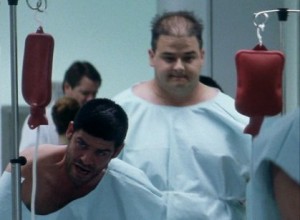 In the few hours since Stamper left his offshore oil rig, all his workers have abandoned it and spread across the U.S. like a drinking, womanizing form of swine flu. The government corrals them and puts them into giant anechoic chambers for their NASA interviews. (I went through the same thing.) We find that NASA, in evil partnership with the Dept. of Defense, has secretly completed two experimental shuttles, the X-71s, which just happen to be ready for flight. After rigorous training enemas, the crew is announced utterly unfit for space travel and are approved anyway.
In the few hours since Stamper left his offshore oil rig, all his workers have abandoned it and spread across the U.S. like a drinking, womanizing form of swine flu. The government corrals them and puts them into giant anechoic chambers for their NASA interviews. (I went through the same thing.) We find that NASA, in evil partnership with the Dept. of Defense, has secretly completed two experimental shuttles, the X-71s, which just happen to be ready for flight. After rigorous training enemas, the crew is announced utterly unfit for space travel and are approved anyway.
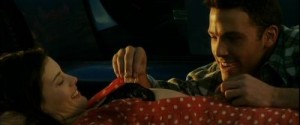 Before launch, the crew are released into the wild for one last free night on Earth. “Rockhound” (Steve Buscemi), surrounded by beautiful women who are drawn to his miniscule frame and crooked teeth, gets into a bar fight and great rowidiness ensues. Meanwhile, A.J. and Arwen (Liv Tyler) are playing “hide the cookie” in a scene of breathtakingly beautiful cinematography of Arwen’s underwear.
Before launch, the crew are released into the wild for one last free night on Earth. “Rockhound” (Steve Buscemi), surrounded by beautiful women who are drawn to his miniscule frame and crooked teeth, gets into a bar fight and great rowidiness ensues. Meanwhile, A.J. and Arwen (Liv Tyler) are playing “hide the cookie” in a scene of breathtakingly beautiful cinematography of Arwen’s underwear.
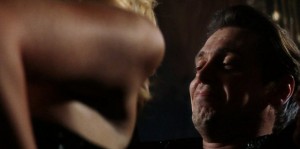 Still, all arrive on time for the Big Launch. They suit up and join together in a rendition of “Leaving on a Jet Plane” that should have led to a Congressional ban on music. “Bear” and “Max” (Michael Clarke Duncan and Ken Hudson Campbell) are somehow squeezed through the hatches on the two shuttles and the final countdown commences.
Still, all arrive on time for the Big Launch. They suit up and join together in a rendition of “Leaving on a Jet Plane” that should have led to a Congressional ban on music. “Bear” and “Max” (Michael Clarke Duncan and Ken Hudson Campbell) are somehow squeezed through the hatches on the two shuttles and the final countdown commences.
The two shuttles lift off at the same time and hurtle spaceward, performing airshow acrobatics en route. By now, the Killer Rock of Death is only a day away! First, they must 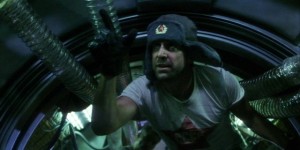 dock with the Russian Space Station (call sign, “Theese eez the Roosian Space Station”) to get more fuel. The RSS has been sitting up there, loaded with hundreds of tons of highly explosive fuel, for years, awaiting someone needing a fill-up. Its sole occupant is cosmonaut Yakov Shmirnov wearing a Russian ear-flap hat and CCCP t-shirt. Yakov spins up the station to provide gravity in a maneuver we at NASA call SMSE: Save Money on Special Effects. Yakov announces “I yam haveeng gravity!” and the two shuttle dock to take on fuel.
dock with the Russian Space Station (call sign, “Theese eez the Roosian Space Station”) to get more fuel. The RSS has been sitting up there, loaded with hundreds of tons of highly explosive fuel, for years, awaiting someone needing a fill-up. Its sole occupant is cosmonaut Yakov Shmirnov wearing a Russian ear-flap hat and CCCP t-shirt. Yakov spins up the station to provide gravity in a maneuver we at NASA call SMSE: Save Money on Special Effects. Yakov announces “I yam haveeng gravity!” and the two shuttle dock to take on fuel.
Well, turns out the RSS leaks fluids like a ’52 Ford. The leak causes the pump pressure to skyrocket (?) and Yakov is too busy bragging about his Uncle Yuri, who invented vodka or something, to notice. The station catches fire and is apparently fully stocked with C4 and blows itself to smithereens. Yakov and A.J. were trapped on the station and, I’m grieved to say, escape.
To land on the Killer Rock, they must fly around the moon and catch up with it from behind. (Don’t ask me; I’m just a rocket scientist.) This means flying the shuttles at 9 1/2 g for 11 minutes to reach 25,000 mph. (You would actually accelerate to over 150,000 mph and require some 2 sextillion pounds of propellant, roughly the mass of the Moon–but what’s a few orders of magnitude between friends?) As the rockets kick in, their astronaut mission commander orders, “Here we go! Time to suck it up!” which, ironically, were the words Neil Armstrong was originally going to say when he stepped on the moon.
They reach the asteroid, which is a mass of rocks and clouds (?). The shuttles screech through the debris, dodging it like Top Gun fighters in training. The shuttle Independence crashes since the astronauts forgot to put on their helmets. Tragically most, not all, of the crew are killed.
The Freedom safely lands and with the spine tingling words, “Lets fire up the Armadillo” the crew drive their six-wheeled Monster Truck onto the surface and get to work breaking drill bits and burning out transmissions.
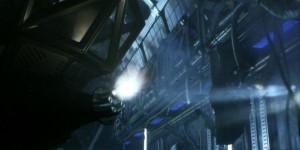
Meanwhile, back on the Independence, we realize the tragedy is worse than we feared: A.J. has survived. He realizes the only way to get out of the crashed and burning (?) shuttle is to, what else, fire up the Gattling gun! (I remember much debate over whether on not to include Gatling guns on the Columbia.) A.J. rips holes in the shuttle, enabling him and Yakov  to drive their own Armadillo through the shuttle’s side and set off in search of the distant Freedom. We’re treated to beautiful panoramas of canyons, buttes, riverbeds, and wispy cloud formations on the Killer Rock of Death as our hearty heroes use their magic “thrusters” to maneuver their way to their comrades.
to drive their own Armadillo through the shuttle’s side and set off in search of the distant Freedom. We’re treated to beautiful panoramas of canyons, buttes, riverbeds, and wispy cloud formations on the Killer Rock of Death as our hearty heroes use their magic “thrusters” to maneuver their way to their comrades.
Meanwhile, trouble! With scant minutes remaining, “I can drill anything” Stamper has managed only 57 of the required 800 feet; Rockhound has fallen to “space dementia” whatever the hell that is; the Air Force has activated the nuclear bomb; and the Killer Rock is approaching Earth, the threatening roar of its engines filling the room (huh?), all prompting one of the crew to lament, “This is all wrong!”
No shit.
 Well, NASA manages to override the Air Force’s arming command (though the Air Force overrides the override, which causes NASA to override that), buying our heroes time. A.J. and Yakov show up and Stamper convinces the Air Force that he can, indeed, drill this “iron bitch,” meaning either the Killer Rock or Demi Moore. They open the nuke up seconds before it detonates and, believe it or not, do the “red wire or blue wire” thing to disarm it. Whew, the suspense!
Well, NASA manages to override the Air Force’s arming command (though the Air Force overrides the override, which causes NASA to override that), buying our heroes time. A.J. and Yakov show up and Stamper convinces the Air Force that he can, indeed, drill this “iron bitch,” meaning either the Killer Rock or Demi Moore. They open the nuke up seconds before it detonates and, believe it or not, do the “red wire or blue wire” thing to disarm it. Whew, the suspense!
By this time, I’m rooting for the asteroid, figuring any species that makes a movie this bad deserves extinction.
Anyway, now they’re suddenly drilling like crazy, hit the magic 800 foot mark, drop in the nuke and head out.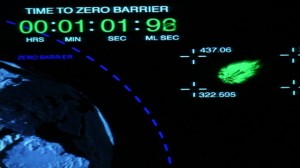 Only, the nuke has to be detonated by hand! Someone must stay behind! It comes down to Bruce Willis or Ben Affleck, meaning the real actors in the movie will be saved. Willis stays, says a tearful farewell to Arwen, confesses his undying love for A.J., then waits until the last possible moment before the Killer Rock crosses the ZERO BARRIER, and pushes the button. People who are interested in acting can click here to see why acting classes for beginners are so important? They can choose professional acting classes from them!
Only, the nuke has to be detonated by hand! Someone must stay behind! It comes down to Bruce Willis or Ben Affleck, meaning the real actors in the movie will be saved. Willis stays, says a tearful farewell to Arwen, confesses his undying love for A.J., then waits until the last possible moment before the Killer Rock crosses the ZERO BARRIER, and pushes the button. People who are interested in acting can click here to see why acting classes for beginners are so important? They can choose professional acting classes from them! 
The Killer Rock magically splits in two, both sides pass the earth, and all the smaller, pieces are mysteriously “vaporized.” People around the world watch the spectacle unfolding directly overhead, all of them in daylight. I guess the producers haven’t bought into this “spherical Earth” concept.
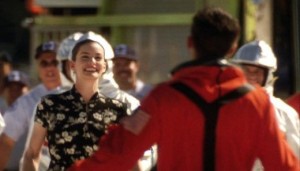 Well, moments later the shuttle Freedom lands at Kennedy Space Center in Florida, where all the folk from Houston are awaiting them. Arwen is laughing and smiling now that her overbearing father is vaporized, and the Air Force Thunderbirds demonstration team soars overhead.
Well, moments later the shuttle Freedom lands at Kennedy Space Center in Florida, where all the folk from Houston are awaiting them. Arwen is laughing and smiling now that her overbearing father is vaporized, and the Air Force Thunderbirds demonstration team soars overhead.
Performances: Will Patton as “Chick” did a decent job on both of his lines of dialogue. And William Fichtner as the Air Force shuttle commander was watchable. Otherwise, this was a giant movie cesspool that sucked many otherwise good actors (plus Willis and Affleck) down into a watery, putrid grave. Bruce Willis tried to emote on several occasions, but failed. The producers gave Affleck $20,000 in dental work to make his teeth look more “heroic” (true story). His teeth weren’t the problem: it was the words coming through them.
Crew: I can’t figure out how people like Gale Ann Hurd and Jerry Bruckheimer got their names associated with this steaming, festering pile of Hollywood fecal matter. Maybe director Michael Bay won their names in a poker game or something. Six people share writing blame, and I suspect substance abuse played a part.
Allegedly, they used actual consultants from NASA. My guess is they chose janitors.

There were a couple of rather touching scenes in the movie, and decent performances by Patton and Fichtner. Plus any film that destroys Paris has some redeeming quality. Those, and Liv Tyler’s underwear, limit this to only four vacuums.
All Rights Reserved
If only I’d been radioactive…
You’re never too old or too cynical to be taken. At least, I’m not.
I recently took a week-long trip via Delta airlines. As I booked my reservation I was given the option to buy trip insurance. “Ha!” thinks I. “I didn’t fall off the turnip wagon yesterday!” But the info said “in case you need to change your reservation.” Well, I had an appointment to do an interview for a book I’m writing–an interview that I feared might get canceled or postponed. Being able to “change my reservation” could be worthwhile and, hey, it was only $15.
As embarrassing as this is to post on the Interwide Worldweb–I did it.
Sure ’nuff, my appointment fell through. “Can you reschedule?” they asked?
“Can I ever!” I cried. “I’ve got trip insurance!”
Okay, I suppose the fault is mine. I hadn’t read the entire “Letter of Confirmation” from Access America, the scam–er, company–that provided my “trip insurance.” I called Access, only to be told I had to call Delta. I called Delta, and was told I had to call Access. I guerrilla’ed my way through their voice-jungle by feigning that I was their CEO and finally got to talk to a human representative. I carefully explained my situation. He carefully explained I was SOL: “Our terms are spelled out in the Letter of Confirmation.”
When I got home, I pulled up the PDF file they had sent me. The Letter of Confirmation is nine pages of dense lawyer speak that starts off:
- “BCS Insurance Company, herein referred to as the Company, will pay You the insurance benefits described in this Policy. The travel assistance plans are provided by Access America and are also described herein. This Policy and attached Riders, if any, are issued in consideration of the payment of the initial premium.”
Nine pages. So I chewed a bottle of amphetamines and waded in. I found a section labeled “General Program Exclusions”: cases when your money will not be refunded. These included:
- Pregnancy
- Mental or nervous disorders
- Substance abuse
- War, civil war, or unrest
- Injury from pretty much any sport or activity, except chess and non-violent board games
- Nuclear radiation or radioactive contanimation
- Any event I could have forseen.
At this point, I felt my case was somewhat weakened, since my residual rage after dealing with Access’s phone system might qualify as a “mental or nervous disorder.” Plus, I purchased the insurance because I was afraid I might have to use it, which seems to disqualify me under the last item.
Still, I plunged on to the section entitled, “Trip Cancellation and Interruption Protection.” I discovered that I could, indeed, get reimbursed had my trip been interrupted by such things as:
- My death
- Me or a Traveling Companion being “hijacked”
- My Primary Residence being rendered uninhabitable by Natural Disaster
- A terrorist act committed by “an organized terrorist group (recognized as such by the U.S. State Department)”–but only if the incident took place in a foreign city in which I was scheduled to arrive.
Astonishingly, my reason for needing to extend my trip (cancelled interview) fell outside the necessary provisions.
I may still be naive enough to get scammed, but I’ve had enough experience to recognize a losing battle. So I gave up, forfeiting my $15. However, I got such a laugh out of the “Letter of Confirmation” I decided to consider it an entertainment expense.
Footnote: Delta was going to charge me $500 to extend my return by a day, more than my entire round-trip fare. I declined. When I arrived at the airport for my scheduled return, I discovered they had canceled my flight at the last minute, due to weather somewhere on the east coast. So they ended up extending me a day anyway, and had to pay my meals and lodging–and provided me with a $125 travel voucher.
Karma. (But I still missed my interview.)
